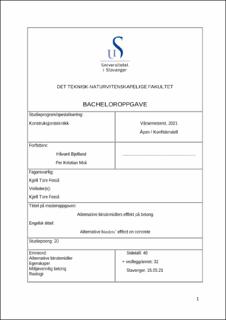Alternative bindemidlers effekt på betong
Bachelor thesis
Permanent lenke
https://hdl.handle.net/11250/2774310Utgivelsesdato
2021Metadata
Vis full innførselSamlinger
Sammendrag
Denne oppgaven tar for seg både de ferske og de herdede egenskapene til miljøbetonger, hvor Anleggsement blir brukt som referanse. Sammen med veileder ble vi enige om en prøveplan over hvilke bindemidler vi skulle ta for oss, for å sammenligne opp mot referanseblandingen. Vi ser nærme på hvordan alternative bindemidler påvirker betongens karaktertrekk, spesielt de reologiske egenskapene, men også egenskaper som trykkfasthet, elastisitetsmodul og bestandighet.
Da oppgaven er todelt, blir aktuell teori fra kjent litteratur og forsøk tatt for seg, hovedsakelig informasjon knyttet til reologien til betong. Flygeaske og slagg sin innvirkning på betongblandingene blir gjennomgått, og gir en viss indikasjon på hva en kan forvente fra resultatene av de ulike forsøkene.
Fra resultatene blir forskjeller, likheter, usikkerheter og feilkilder diskutert nøye i resultatdelen. Resultatene blir gjennomgått steg for steg ved hjelp av tabeller og figurer som er hentet fra testene. Resultatene fra de ferske testene viser at anleggsbetongen gir best støpelighet. Trykkfasthet viser en treigere fasthetsutvikling for Anleggsement FA enn for referanse blandingen. Dette gjaldt også for Lavvarmebetongen. Begge betongene med alternative bindemidler har en høyere porøsitet, som også gir en lavere elastisitetsmodul. This thesis deals with both the fresh and the hardened properties of environmental concrete, where Construction Cement is used as a reference. Together with the supervisor, we agreed on a test plan of which binders we should use to compare against the reference mixture. We take a closer look at how alternative binders affect the concrete's characteristics, especially the rheological properties, but also properties such as compressive strength, modulus of elasticity and durability.
As the thesis is divided into two parts, current theory from known literature and experiments are considered, mainly information related to the rheology of concrete. Fly ash and slag's impact on the concrete mixtures are reviewed and gives a certain indication of what can be expected from the results of the various experiments.
From the results, differences, similarities, uncertainties, and sources of error are carefully discussed in the results section. The results are reviewed step by step using tables and figures taken from the tests. The results from the recent tests show that the construction concrete gives the best workability. Compressive strength shows a slower strength development for Construction Cement FA than for the reference mixture. This also applied to the Low Heat Concrete. Both concrete with alternative binders have a higher porosity, which also gives a lower modulus of elasticity.
